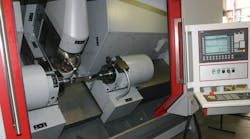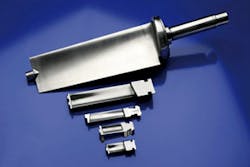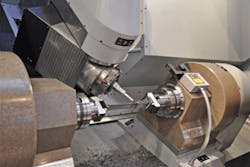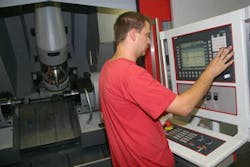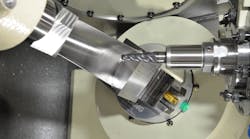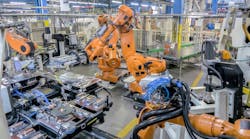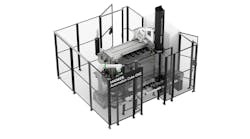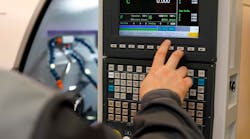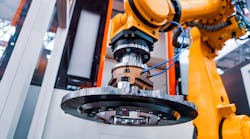The complete machining of turbine blades requires a manufacture to strike a balance between powerful roughing and ultra-precise finishing — a task for which modern, five-axis turning-milling centers are well suited, as long as the stability and sturdiness of the machine construction is combined with high-quality drive and control engineering.
For machine tool builder, Hamuel Maschinenbau GmbH & Co. KG, experience is one element of high-quality construction. The German company has been building machines for 85 years, and CNC machines for the past 35 years. Add to this its 25-year record for building five-axis simultaneous machining systems, and more than 10 years’ experience in the construction of five-axis turning-milling centers. CEO Dr. Markus Stanik acknowledged that experience alone is no indicator for the quality of machine tools, but, “It certainly helps us, together with the right partner companies, to design and build the machines so that our customers can be successful in the marketplace."
Hamuel’s emphasizes three aspects of its machine-building capability:
• Its production of machine-tool components (e.g., axis units, machine bases and machine bodies);
• Its development and construction of CNC-gantry milling machines; and,
• Its production of five-axis turning-milling centers.
The last of these, as demonstrated by Hamuel’s HSTM (high-speed turning-milling) series introduced in 1999, is a significant part of the success of the company. The world’s most successful manufacturers of aerospace and industrial-gas turbines are particularly impressed by the responsiveness, capability, and precision of these machines.
HSTM machines running on Siemens’ Sinumerik 840D sl CNC controllers are used mainly to manufacture turbine blades and blisks (turbine disks) deployed in stationary steam and gas turbines, as well as in mobile turbines for aircraft jet engines and large turbochargers. These products always consist of high-strength materials, such as titanium or high-alloyed steels. Form deviations are unacceptable in such applications, because even the smallest error would significantly reduce the efficiency of the turbines. Correspondingly high and comprehensive requirements are placed on the machine tools.
Productivity and Accuracy
“Our customers normally manufacture large turbine blades longer than approximately 1000 mm from forging blanks,” Hamuel sales manager Dipl.-Ing. Jochen Schaede explained. “In contrast, shorter workpieces are milled from a solid piece of material with a stock-removal ratio of approximately 80 percent. This makes it obvious that our machines must not only rough-cut very productively but also finish with high precision."
Whereas productivity takes precedence for rough cutting, accuracy is more important for the subsequent finishing of the spatial free-form surfaces. “With regard to accuracy, our high-performance machining centers achieve a precision in the micrometer range coupled with excellent surface quality," Schaede added.
This capability is achievable because of the combination of compact machine construction together with perfectly matched drive and control engineering. The foundation is the robust machine design with a unitized machine base – either as welded construction cast with special concrete or, more recently, polymer-concrete, made from a single piece of material. The careful distribution of the masses ensures the best dynamic rigidity.
The experience of the Hamuel developers together with the knowledge of the Siemens mechatronic experts make such results possible.
"Thanks to various simulation tools, the Siemens engineers could provide us with very exact data to which we could add or remove masses,” Jochen Schaede confirmed. “It was certainly advantageous that we could procure all components required for the dynamics from Siemens starting with the spindle, including the axis drives, and ending with the CNC. This means we needed only a few iteration loops in order to obtain a perfect dynamic rigidity in the machines."
It is important also that each component is arranged so that the horizontally clamped turbine blades and blisks can be machined optimally. This is also facilitated by the 45°-inclined orientation of the axes, ensuring favorable swarf removal, further augmented by the permanent rinsing of the machine internal area.
Accessibility also is enhanced by this inclined axis orientation.
These special-purpose HSTM machines, equipped with Siemens direct drives, achieve a maximum positioning accuracy of 5 µm with traversal speeds exceeding 40 m/min in all linear axes. Indeed, the extremely fast rotary axes have a positioning accuracy of 3 µm. This allows the user to achieve maximum productivity, but with accuracy: surface finishes are in the range of Ra = 0.8 µm, and thereby fully match the industry requirements placed on the blade machining.
Optimized Surface Transitions
One of the greatest challenges for turbine-blade manufacturers concerns the critical surface transitions (leading and trailing edges) of the turbine blades. To achieve high quality, the milling paths described with curve interpolation points must have a constant machining speed. As a consequence, the leading and trailing edges demand extreme angular accelerations. The number of curve interpolation points to be described is correspondingly quite high.
The controller faces the challenge of reliably processing the generated NC steps that are supported by the fast block cycle times and the look-ahead function of the CNC. "Hardly any other controller can supply the drive information for all five axes in the required short time as reliably as the Sinumerik 840D sl controller,” Jochen Schaede confirmed.
"The new Advanced Surface motion control that includes (among other things) an optimized look-ahead function is also excellent,” he continued. “And, I would also like to mention the five-axis high-speed turning-milling of free-form surfaces requires a continuous spatial reorientation of the geometry vectors." This leads to the use of the Traori (transformation orientation) principle in the Sinumerik 840D sl. Therefore, Hamuel machine operators can achieve reproducible results with the best-possible surface finish, exact contour accuracy and with the maximum possible machining speed.
In addition to the primary properties of precision, productivity and reliability, Hamuel also appreciates other advantages of Siemens’ drive and control engineering.
For example, the DRIVE-CLiQ interface: When this digital connection is used, all appropriately equipped drive components are detected automatically. Only a connection cable is required to achieve this result. Equivalent circuit diagram data for the motors and the characteristic values of the installed encoder systems are all stored. This avoids the need for manual data input during the commissioning, making this task more reliable and much faster, according to Hamuel engineers.
Sales manager Schaede is impressed with the “know-how” protection onboard the control. With the help of the software, machine operators can protect all their programs and their application know-how, using individual passwords, and so largely prevent unauthorized access.
According to Hamuel, the teleservice consultation offered by Siemens has been an advantage for its machine users, who are established around the world. It not only makes it possible for software problems to be rectified, but it allows updates to be installed fast and reliably, without needing to be present onsite. Manufacturing operations save time and money and they always remain up-to-date with the latest software releases, via this service.
Powerful Motor Spindle
The capability of the turning-milling center also depends on the 54-kW motor spindle made by Weiss Spindeltechnologie GmbH, a Siemens subsidiary. Equipped with a HSK A63 tool holder, it provides the high torque required for roughing, plus speeds as high as 16,000 rpm for finishing. This guarantees an optimal cutting speed at all times. As a practical detail, the Hamuel engineers also emphasize the integrated Hirth gearing that makes it possible to clamp the spindle and relieve load on the bearings during the turning process.
The machine sizes in the HSTM Series are oriented to the length of the workpieces to be produced, in standard ranges from ≤ 500 mm (HSTM 300) to 1,750 mm (HSTM 1500). On special request, Hamuel also builds larger machines. A project for machining blades as large as 2,500 mm in length is currently in commercial production. "Thanks to our modular machine construction, we are able to satisfy special requests and build turning-milling centers in these dimensions," CEO Markus Stanik explained.
New developments (now in the introductory phase) are evolving at Hamuel. For example, in the near future, a special gas will be able to be used to cool the tool in the HSTM machines, and a machine base made of a mineral casting is available now.
“This material not only exhibits excellent properties with regard to vibration suppression but we have also been able to reduce somewhat our dependency on steel suppliers,” noted Stanik. For the machine user, this is apparent in the improved surface quality of its finished products and in significantly longer tool service life.
